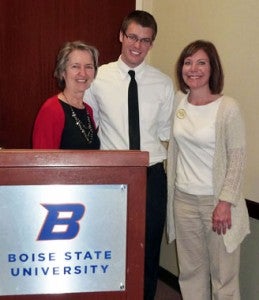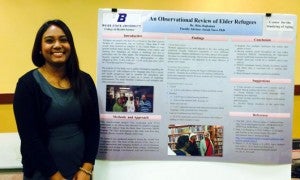
Boise State is a national leader in providing the unique opportunity for pre-baccalaureate students to explore and research issues that relate locally, nationally and around the world. Few university experiences offer a richer education than standing shoulder-to-shoulder with scholars and researchers working on society’s most important questions and challenges. Individually or as part of a team, they hone problem solving and critical thinking skills that will serve them for a lifetime, no matter the direction their career paths follow.
At the annual Undergraduate Research Conference, Boise State undergraduates have the opportunity to demonstrate what they have learned through their research, scholarship, or the arts. Students may present their work in poster, podium presentation, or visual formats.
In addition to 19 College of Health Sciences students participating in the university event, the college, in partnership with the Friends of Nursing at Boise State, hosted a “Conversations in Health Sciences” on April 21, immediately following the Boise State Undergraduate Research Conference. Conversations in Health Sciences is a forum where alumni and friends can delve deeper into current health science topics with professors and students at Boise State through listening, learning, and discussion.
Alumni, current students conducting research, donors and friends of the College of Health sciences were invited to attend Conversations in Health Sciences to hear about two stellar student/faculty research teams’ projects, ask questions and network with the faculty, students, and each other.
The first presentation, given by Alia Crandall, a Nursing student, with mentoring from Marty Downey, faculty in the School of Nursing, was in regards to the concurrence of anxiety and/or nausea in cancer patients undergoing port access for breast cancer and whether or not aromatherapy has an effect on either anxiety or nausea, or both. Do both always occur together and at the same time or are they separate from each other? Two different scents are being tested and compared by being applied to a card that participants can pin on to their clothing fairly close to the nasal passages. The evaluation project is just getting underway and new participants are identified each day for further analysis.
The second presentation, given by Brittney Ramert, a Health Science Studies student, with mentoring from Sarah Toevs, faculty in the Department of Community and Environmental Health, was about how to meet the healthcare needs of a rural state and the role that telehealth systems might play in that objective. Ramert demonstrated how Alaska has used telehealth for many years very successfully and that Idaho and Alaska have a number of commonalities which indicate that telehealth could be beneficial to Idaho as well. There is currently a rather robust telehealth system used at the VA Medical Center in Boise, but there are many more opportunities to utilize it to the benefit of Idaho citizens of all ages.

Below is a list of the projects presented during the university Undergraduate Research Conference.
Podium Presentations:
- Idaho CareLine 2-1-1 Data Analysis and Update to Idaho Legislators, podium presentation by Catherine Dickson, Health Sciences Studies student, and Adiya Jaffari, Pre-Medical Studies student, with faculty sponsor Mike Berlin, faculty in the Department of Community and Environmental Health
- Powerful Tools for Caregivers: An Analysis of Program Effectiveness and Impact, Judy Lui, Health Science Studies student, with faculty sponsor Toevs
- An Observational Study Among Refugee Students Over 60 Years Old, Rina Rajbahak, Health Science Studies student, with faculty sponsor Toevs
- Telehealth System to Improve Medication Management of Autism Spectrum Disorder Remotely, Tiffany Worthington, Health Science Studies and Pre-Physician Assistant student, with faculty sponsor Uwe Reischl, faculty in the Department of Community and Environmental Health
Poster Presentations:
- Health Literacy of Older Refugees and Its Impact on Health Communication with Health Care Providers, Mohamed AlMehawes, Health Science Studies student, with faculty sponsor Toevs
- Visual Influences on Self-Served Foods, Tami Cirerol, Health Science Studies student, with faculty sponsor Mary Pritchard, Department of Psychological Science
- Concurrence of Anxiety and Nausea in Cancer Patients Undergoing Port Access, Alia Crandall, Nursing student, with faculty sponsor Downey and Heather Roberts, St. Luke’s Mountain States Tumor Institute, Twin Falls, Idaho
- Pharmacy Elder Abuse Assessment Project, Alexandrea Ham, Health Science Studies and Pre-Pharmacy student, with faculty sponsor Toevs
- Performance Comparison of Oxygen Delivery Devices in Patients with Varying Inspiratory Demands, Gwendolyn Hinten, Melynda Lewis, and Jared Eardley, Respiratory Care students, with faculty sponsor TJ Wing, Department of Respiratory Care
- Living Well in Idaho, John Manning, Health Science Studies student, with faculty sponsor Toevs
- Effect of ATC on Tidal Volume with Varied Amplitude, Lonny Niejadlik and Kortnee Fleming, Respiratory Care students, with faculty sponsor Lonny Ashworth, Department of Respiratory Care
- Meeting the Healthcare Needs of a Rural State, Brittney Ramert, Health Science Studies student, with faculty sponsor Toevs
- Drug-resistant Ovarian Cancer Cells Killed by Nullomer Peptide Drugs, Dustin Theis, Pre-Medical Studies and Chemistry student, with faculty sponsor Greg Hampikian, Department of Biological Sciences
- Telehealth System to Improve Medication Management of Autism Spectrum Disorder Remotely, Tiffany Worthington, Health Science Studies and Pre-Physician Assistant student, with faculty sponsor Reischl, faculty in the Department of Community and Environmental Health
- Measured Expiratory Resistance of the Blue and Green Acapella Devices as Setting is Increased From 1–5; Amplitude 20, 30, 40, Amanda Wroblewski and Scott Hawkins, Respiratory Care students, with faculty sponsor Ashworth